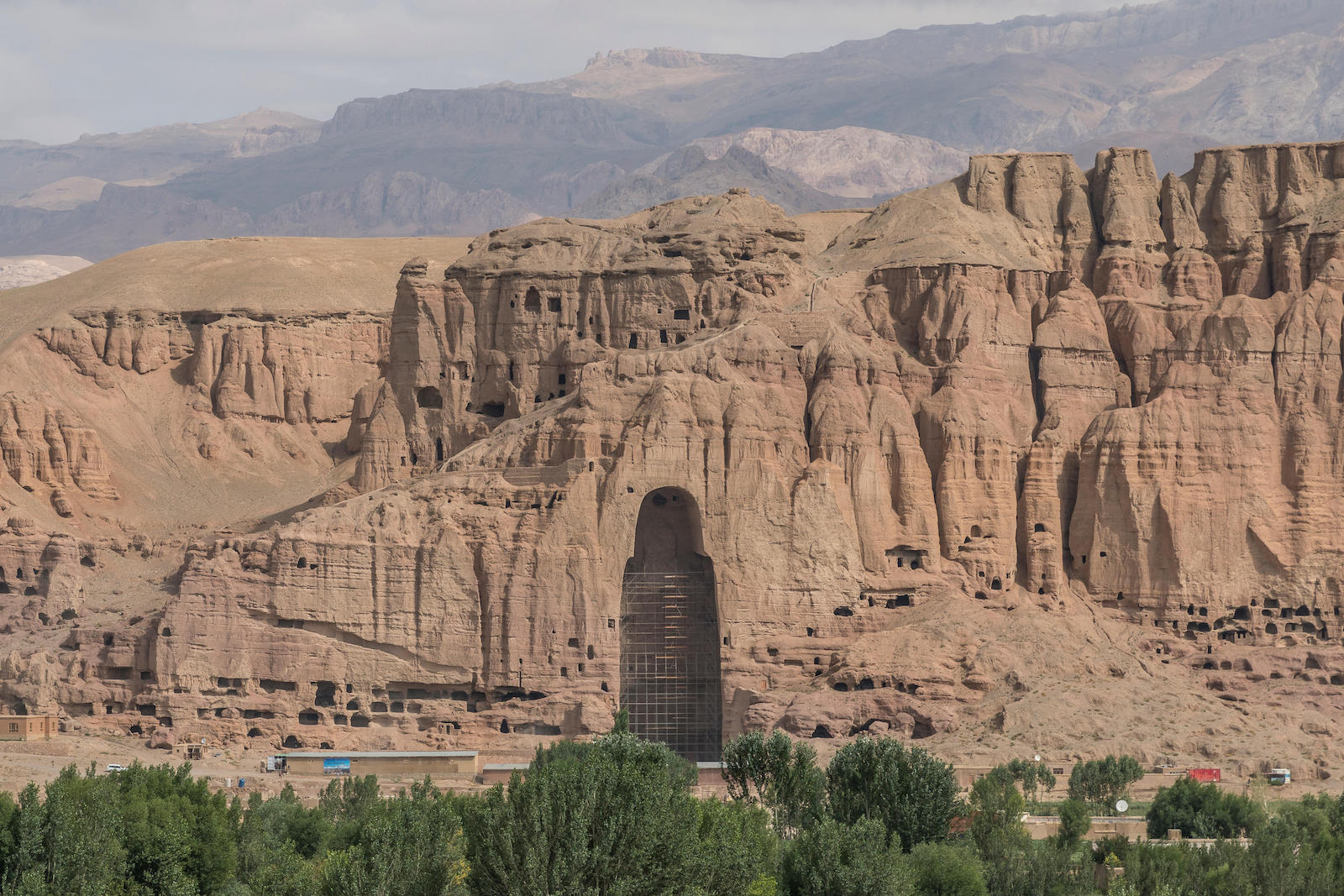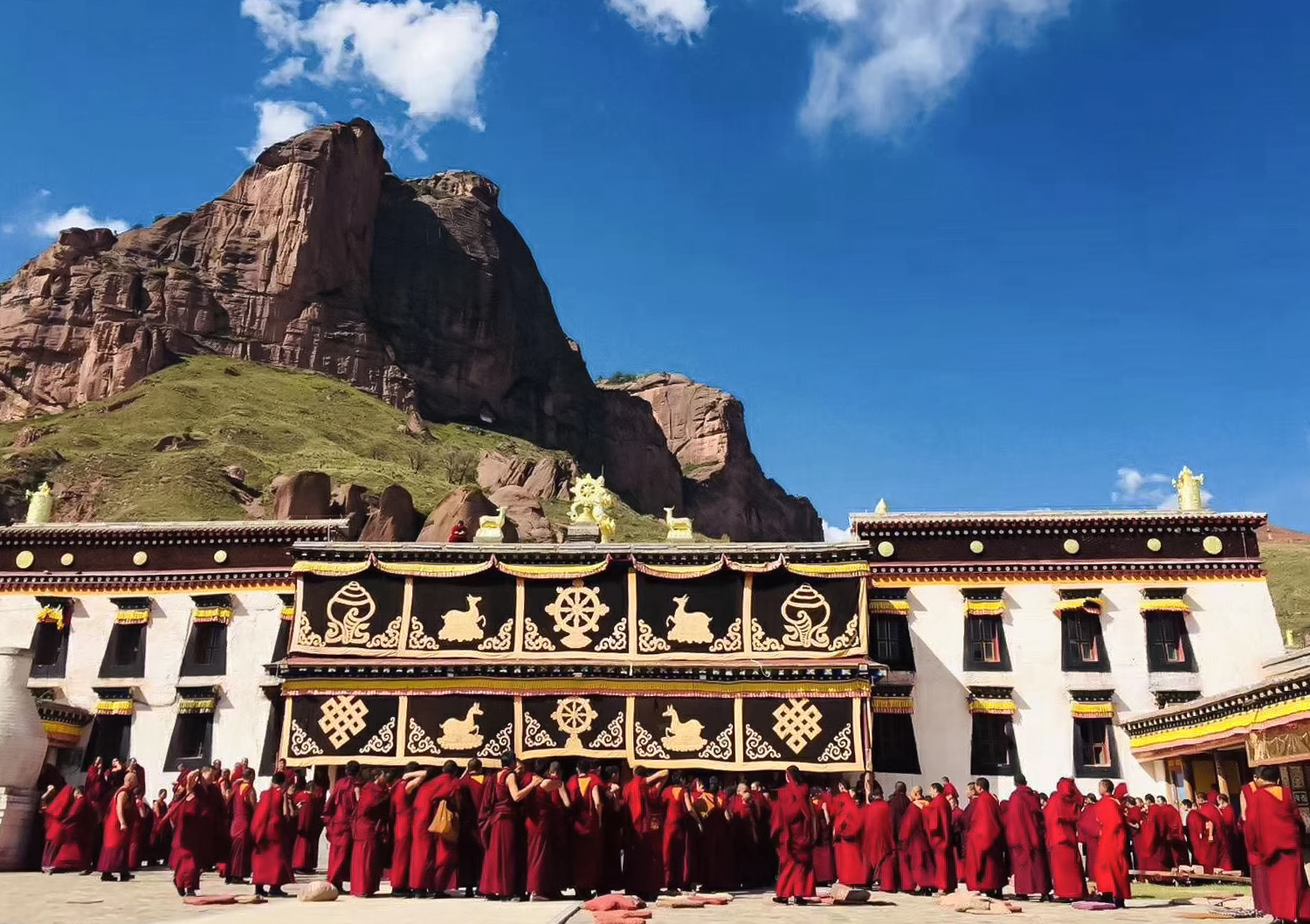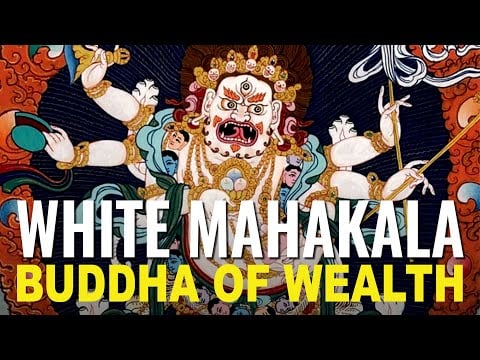Video: Unshakable Power Akshobhya Buddha 阿閦佛 Vajra Lord: Dharani, Mantra Practices & Sadhana
Which parable in the Lotus Sutra is the story of Akshobhya Buddha, the glorious Eastern Buddha? Why is Akshobhya Buddha the very face of unshakable peace? Why is the family blue, and what is the significance of the great...


Which parable in the Lotus Sutra is the story of Akshobhya Buddha, the glorious Eastern Buddha? Why is Akshobhya Buddha the very face of unshakable peace? Why is the family blue, and what is the significance of the great Vajra? We answer these questions and more and end with the mantras, practices and a Sadhana visualization of Akshobhya Buddha.
Video:
CONTENTS
00:00-01:02 Introduction Akshobhya Buddha Vajra Lord
01:02-02:03 Unshakable: Akshobhya’s as a Monk from Sutra
02:03-02:49 Unshakable Buddha and his Vajra Vow
02:49-03:47 Akshobhya’s Mirror-Like Wisdom: “Mind like a Sheet of Water” Thich Nhat Hanh
03:47-04:20 Mirrors and Vampries
04:20-07:08 PARABLE OF THE MAGIC CITY: Lotus Sutra
07:08-08:08 Skillful Means and Countless Forms of Enlightenment
08:08-09:02 Vajra, the Powerful Symbol of Akshyobhya and eternal Buddha Nature
09:02-10:35 Most Blue Deities such as Hevajra, Guyasmaja, Chakrasamvara are emanations of Akshobhya Buddha
10:35-10:56 How does Akshobhya’s practice overcome anger?
10:56-11:48 Why is Water Akshobhya’s element?
11:48-14:00 Blue, symbols, mudra, posture, appearance, sacred animal
14:00-14:36 Seed Syllable Hum and Buddha Mind
14:36-15:52 Sacred Dharani in Sanskrit purifies all negative karma
15:52-16:23 Heart Mantra three times
16:23-19:00 Short Sadhana, visualization, prayer and Dharani by Kamra Chakme
TRANSCRIPT
Akshobhya literally means “unshakable.” One of Akshobhya’s great vows is to never become angry until reaching enlightenment. In his Sutra, the Akṣhobhya Tathagatasya Vyuha Sutra, we hear the story of Akshobhya as a monk in an earlier life. He vows, in the Sutra:
“Now that I have become a bodhisattva, I will never allow myself to get angry at any living being.”
While still a monk, nothing could shake him, anger him or move him to rage. He aspired to practice the Dharma in the eastern world of delight and made a vow not to harbor anger or malice towards any being until he achieved enlightenment. He remained “unshakable” and later became the buddha Akshobhya of the Eastern Pureland Abhirati, who is called the Unshakable One.
This is reflected today in the Vajra or Unshakable vow we take at Vajrayana empowerments. There is a vow for each of the five Buddhas. Akshobhya’s vow that many practitioners renew every day is:
I shall uphold purely
The vajra, bell and mudra of
The great, supreme Vajra family,
And I shall uphold purely the Master commitment.
It is partially because of this vow we hold the Vajra and Bell as our main spiritual tools.
Akshobhya’s wisdom is Mirrorlike Wisdom which overcomes the poison of anger.
In a pond’s still waters we may see a reflection of a beautiful moon and think it is real. But, if we throw a stone in the water, causing ripples, this reflection of the moon is distorted, or disappears. In this metaphor, if our mind is busy or stressed, we cannot see, like the ripples in the water.
Thich Nhat Hanh, a renowned Zen Master taught the concept this way:
“The mind is like a sheet of water, calmly reflecting the reality as it is. When the water is still, it can hold the image of the reality exactly as it is, with no distortion”.
This metaphor also arises from the old superstitions of many countries on the power of mirrors. In these legends, mirrors cannot reflect evil or illusory beings. This is the source of vampire lore, where if we look at a person in the mirror, if we see nothing reflected that person is a vampire. This is because their evil nature is illusory.
In The Parable of the Magic City in the Lotus Sutra chapter 7, Shakyamuni Buddha tells the story of Akshobhya Buddha.
In the Parable, Akshobhya Buddha is the “leader” of the people trying to reach the city. Shakyamuni Buddha tells the story:
“There is a road, five hundred miles long, steep, dangerous and bad, an uninhabited and terrifying place. A large group of people wish to travel this road to reach a cache of precious jewels.
Among them, there is a guide, Akshobhya, intelligent, wise and clear-headed, who knows the road well, both its passable and impassable features, and who wishes to lead the group through this hardship.
Midway, the group he is leading grows weary and wishes to turn back. They say to the guide,
“We are exhausted and afraid. We cannot go forward. It’s too far. We want to turn back now.”
To help them, Akshobhya through his power, manifests a spectacular city in the centre of the dangerous road. Akshobhya says to them,
Do not be afraid!
Do not turn back!
Stay here now in this great city I have created just for you.
If you go into this city, you will be happy and at peace. If you then wish to proceed to the jewel treasure in future, you may do so.
Then the exhausted group rejoiced greatly, having gained what they had never had. They thought:
“We have now escaped this bad road and gained happiness and peace.”
Then the group went forward and entered the transformed city; thinking that they had already been saved, they felt happy and at peace.
Later, Akshobhya, the guide, knowing that they were rested and no longer weary, made the city disappear, and said to them.
“All of you, come. Let us go. The jewel treasure is near. The great city was merely something I created to give you a rest.”
The story in chapter 7 of the Lotus Sutra, of the magical city of Akshobhya ends by comparing Shakyamuni, the Thus Come One, to the guide in the story:
“Bhikshus. The Thus Come One is also like this. He now acts as a great guide for all of you.
He knows that living beings should leave and cross over the evil road of the torments of birth and death which is so steep, difficult and long. He shall respond to and save them.”
The parable acts as a poignant reminder that we need skillfull means, and calm, reflective wisdom to navigate through life.
It also is a parable that illustrates the countless forms of Enlightenment. Akshobhya Buddha can manifest in any form, and even manifest beautiful cities, to skillfully help motivate us up the path.
Their leader, who was Buddha Akshobhya, had this thought;
“How pitiful they are. How can they renounce the great and precious treasure and wish to turn back?”
For this reason, he uses skillful means to keep them motivated until they attain the treasure — which is Enlightenment.
The great symbol for the unshakable nature of the Akshobhya family is the iconic and powerful vajra, often called the diamond scepter, not because it’s made of diamond, but because, like a diamond, it is indestructible. Why is it indestructible? Because it symbolizes Buddha Nature. Buddha Nature is eternal and universal.
Like that, we too, are indestructible or immortal because our essence has never died and never will die. Our true essence, our Buddha Nature, is eternal. This becomes clear, as we practice Akshobhya Buddha’s clarity practices.
In Vajrayana, most of the blue forms of Highest Yoga deities are “forms of Akshobhya Buddha,” according to Jeff Watt, eminent scholar at Himalayan Art. See the video linked at the information icon. He said:
“We have deities such as Chakrasamvara, Hevajra, Guhyasamaja — all of these generally are blue in color. Guhyasamaja is actually named Akshobhya Vajra Guhyasamaja. So, this form of Guhyasamaja, blue in color is actually Akshobhya. Akshobhya manifesting as Guhyasmaja.”
He goes on to explain that the blue forms of most Highest Yoga practices are emanations of Akshobhya Buddha. For instance, he adds:
“Chakrasamvara is represented by all five families. But, his main representation, is blue in color, which you see in paintings, and this is the Akshobhya form. And it’s the same with Hevajra. And the same with many, many other Anuttara deities.”
All of these skillful forms, like the magical city in the Lotus Sutra, are none other than Akshobhya Buddha, with practices focused on specific needs or issues.
How does his practice overcome anger? We achieve this through his various sadhanas, mantras and meditations, which express the Wisdom of Reflection. It is, through pausing and reflecting and remaining calm, that we overcome our anger.
For this reason, Akshobhya’s Vajra family became associated with water, representing “reflections on the surface” and also the coolness of water. He is symbolically blue, as are all the deities associated with conquering wrath from his family.
Akshobhya Buddha, his wisdom partner Lochana, their spiritual son Bodhisattva Vajrapani, and Medicine Buddha are all associated with the East, water, blue and unshakable, reflective wisdom.
Reflecting this, his face is serene and blue, like cool, refreshing water. He is seated on a lotus throne in unshakable vajra posture. His right hand touches the earth, in the bhumisparsha mudra, the very same gesture Shakyamuni used to indicate that mother earth was his witness, and signifying his unshakable vow.
His left hand is in the mudra of meditative equipoise on his lap, often with the indestructable vajra in his hand. Even his great sacred animal, the giant irresistable power of the elephant, symbolizes his unshakable nature.
Blue is symbolic of Shunyata, and of emptiness, with the metaphor of the great ocean. In the Buddhist metaphor, we are each a “drop of water” which appears distinct, but its ultimate reality is “water” and when the water drops gather they become a stream, and stream joins a river and river flows into the seas where all waters on earth are ultimately of one essence. In other words, Emptiness is none other than Oneness, undifferentiated from all.
Water is the source of life. We arose from the oceans. Water can be both serene, the trickle of a stream, and vast and angry, like the tempestuous ocean. Water can erode rock. It’s power is tidal — just as the Vajra family is considered the most potent of powerful forces.
For these reasons, we think of Akshobhya, and all the members of the Vajra family, as awesome and powerful forces, irresistible and unshakable, but also calming and healing.
They also represent Buddha Mind. This is why Hum is his seed syllable, as it represents Enlightened Mind.
His Dharani from his great Sutra is considered very powerful and purifies all negative karmas, including those created by the five heinous crimes. For beings who have already died, the recitation of this mantra dedicated for them instantly delivers them from the lower worlds. In Sacred Sanskrit, from Sutra, the Dharani is
Namo Bhagavate. Akshobhya tathagatayarhate samyaksam buddhyaya. Tadyata: Om kamkani kamkani rochani rochani trotani trotani trasani trasani pratihana pratihana sarva karma param parani me svaha sattvanancha svaha.
The Dharani again is.
Namo Bhagavate. Akshobhya tathagatayarhate samyaksam buddhyaya. Tadyata: Om kamkani kamkani rochani rochani trotani trotani trasani trasani pratihana pratihana sarva karma param parani me svaha sattvanancha svaha.
There is also a shorter version of this Dharani that shortens the Namo praise, which is used in the Short Sadhana we narrate at the end of this presentation.
His heart mantra three times is
Om Akshobhya Hum.
Om Akshobhya Hum.
Om Akshobhya Hum.
Recite along with us now, the short Sadhana by Karma Chakmé to help bring Akshobhya’s wisdom and blessings into our lives. If you do not have empowerment, you may still practice, visualizing Akshobhya’s merit field in front of you.
Namo Bhagavate. Akshobhya tathagatayarhate. samyaksam buddhyaya.
Namo Dharmaya
Namo Sanghaya
I visualize the Bhagavān Akshobhya in front of me,
Complete with the major and minor marks and in Nirmāṇakāya aspect,
And seated upon a throne supported by elephants.
At his heart, upon a moon-disc, is a blue hūṃ,
Around which the mantra rotates to the right,
Sending out powerful rays of deep blue light.
Through this, I visualize, the karmic obscurations
Of all sentient beings, especially of those who have passed away,
Disappear entirely, just like frost in sunlight!
Namo ratna trayaya
Om kamkani kamkani rochani rochani trotani trotani trasani trasani pratihana pratihana sarva karma param parani me svaha sattvanancha svaha.
Namo ratna trayaya
Om kamkani kamkani rochani rochani trotani trotani trasani trasani pratihana pratihana sarva karma param parani me svaha sattvanancha svaha.
Namo ratna trayaya
Om kamkani kamkani rochani rochani trotani trotani trasani trasani pratihana pratihana sarva karma param parani me svaha sattvanancha svaha.
We dedicate the merit of this practice to the cause for Enlightenment for the benefit of all sentient beings.

 FrankLin
FrankLin 































